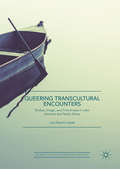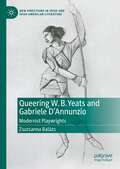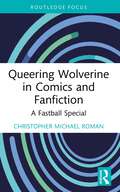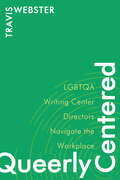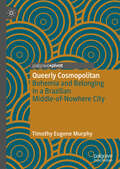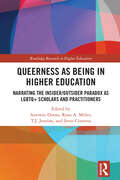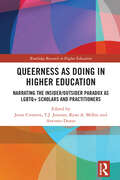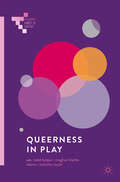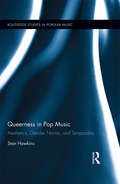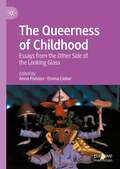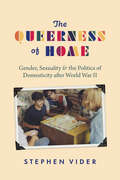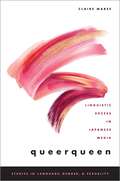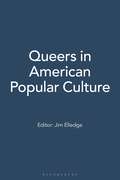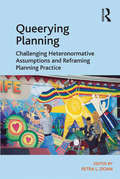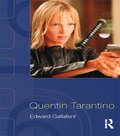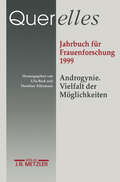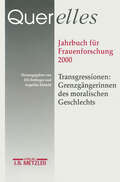- Table View
- List View
Queering Transcultural Encounters: Bodies, Image, and Frenchness in Latin America and North Africa (Palgrave Studies in Globalization and Embodiment)
by Luis Navarro-AyalaIn a highly original and interdisciplinary work bridging French and Francophone studies, cultural studies, media studies, and gender and sexuality studies, Luis Navarro-Ayala examines the transnational queer body as a physical and symbolic entity intrinsically connected with space. Through a transcultural and intersectional approach to bodily representations, socioeconomic conditions, and postcolonial politics, Navarro-Ayala analyzes queerness and Frenchness in narratives from North Africa and Latin America, revealing that Frenchness is coded to represent a sexually deviant “Other.” France and Frenchness, in two distinct regions of the global South, have come to represent an imagined queer space enabling sexual exploration, even in social conditions that would have otherwise prevented queer agency.
Queering W. B. Yeats and Gabriele D’Annunzio: Modernist Playwrights (New Directions in Irish and Irish American Literature)
by Zsuzsanna BalázsQueering W. B. Yeats and Gabriele D’Annunzio: Modernist Playwrights challenges the general resistance in scholarship and queer studies to approach Yeats and D’Annunzio through a queer lens because of their controversial affiliations with fascism and elitism, their heterosexuality and their venerated canonical status. This book provides the first fully theorised queer and comparative reading of Yeats’s and D’Annunzio’s drama. It offers the novel contention that due to their increasing involvement in queer and feminist subcultures, their plays feature feelings that are associated with queer historiography and generate ideas that began to be theorised by queer studies more than half a century after the composition of the plays. Moreover, it uncovers an alert, subversive and often coded social commentary in eight key dramatic texts by each playwright and at the same time highlights the thus far neglected commonalities between the plays and the queer historical as well as cultural contexts of these two prominent modernists.
Queering Wolverine in Comics and Fanfiction: A Fastball Special (Routledge Focus on Gender, Sexuality, and Comics)
by Christopher Michael RomanQueering Wolverine in Comics and Fanfiction: A Fastball Special interrogates the ways in which the Marvel Comics character Wolverine is a queer hero and examines his representation as an open, vulnerable, and kinship-oriented queer hero in both comics and fanfiction. Despite claims that Wolverine embodies Reagan-era conservatism or hegemonic hypermasculinity, Wolverine does not conform to gender or sex norms, not only because of his mutant status, but also because his character, throughout his publication history, resists normalization, making him a site for a queer-heroic futurity. Rather than focusing on overt queer representations that have appeared in some comic forms, this book explores the queer representations that have preceded Wolverine’s bisexual and gay characterizations and in particular focuses on his porous and vulnerable body. Through important, but not overly analyzed storylines, representations of his open body that is always in process (both visually and narratively), his creation of queer kinships with his fellow mutants, and his eroticized same-sex relationships as depicted in fanfiction, this book traces a queer genealogy of Wolverine. This book is ideal reading for students and scholars of comics studies, cultural studies, gender studies, sexuality studies, and literature.
Queering Wolverine in Comics and Fanfiction: A Fastball Special (Routledge Focus on Gender, Sexuality, and Comics)
by Christopher Michael RomanQueering Wolverine in Comics and Fanfiction: A Fastball Special interrogates the ways in which the Marvel Comics character Wolverine is a queer hero and examines his representation as an open, vulnerable, and kinship-oriented queer hero in both comics and fanfiction. Despite claims that Wolverine embodies Reagan-era conservatism or hegemonic hypermasculinity, Wolverine does not conform to gender or sex norms, not only because of his mutant status, but also because his character, throughout his publication history, resists normalization, making him a site for a queer-heroic futurity. Rather than focusing on overt queer representations that have appeared in some comic forms, this book explores the queer representations that have preceded Wolverine’s bisexual and gay characterizations and in particular focuses on his porous and vulnerable body. Through important, but not overly analyzed storylines, representations of his open body that is always in process (both visually and narratively), his creation of queer kinships with his fellow mutants, and his eroticized same-sex relationships as depicted in fanfiction, this book traces a queer genealogy of Wolverine. This book is ideal reading for students and scholars of comics studies, cultural studies, gender studies, sexuality studies, and literature.
The Queeriodic Table: A Celebration of LGBTQ+ Culture
by Harriet DyerCelebrate the richness of modern queer culture and its vast history with this fascinating introduction to all the essential elements that helped sculpt the LGBTQ+ community up to the present day, including:the amazing stories of queer pioneers like Marsha P. Johnson, celebrities, game-changers and unsung heroes alikethe essential LGBTQ+ timeline of queer world historythe biggest queer culture festivals and events in the worldclassic works of queer art, literature, music, TV and filmThis cheerful collection shines a light on the rich variety of elements that form The Queeriodic Table.
Queerly Centered: LGBTQA Writing Center Directors Navigate the Workplace
by Travis WebsterQueerly Centered explores writing center administration and queer identity, showcasing LGBTQA labor undertaken but not previously acknowledged or documented in the field’s research. Drawing from interviews with twenty queer writing center directors, Travis Webster examines the lived experiences of queer people leading writing centers, the promise and occasional peril of this work, and the disciplinary implications of such work for writing center administration, research, and praxis. Focused on directors’ queer histories, administrative activisms, and on-the-job tensions, this study connects and departs from oft-referenced lenses, such as emotional and invisible labor, for understanding work in higher education. The first book-length project that exclusively bridges writing centers and LGBTQA studies, Queerly Centered is for researchers, administrators, educators, and practitioners of all orientations and backgrounds in writing center and writing program administration, rhetoric and composition, and higher education administration.
Queerly Cosmopolitan: Bohemia and Belonging in a Brazilian Middle-of-Nowhere City
by Timothy Eugene MurphyAn ethnography of urban citizenship, global belonging, and queerness in a rapidly growing provincial city in the Global South, Queerly Cosmopolitan explores how people develop a sense of belonging in a city understood by many to be “unimportant” and “in the middle of nowhere.” In his exploration of the city of Teresina and its inhabitants’ attempts to establish a sense of belonging and self-worth, Timothy Eugene Murphy creatively employs queer theory to investigate a community of bohemians. As he follows the participants through different realms of life—nocturnal bohemia, work, family, and intimate friendships—Murphy demonstrates how widely circulating cultural forms, from music to sexuality, offer upwardly mobile communities ways to fashion cosmopolitan lives in even the most peripheral locations.
Queerness as Being in Higher Education: Narrating the Insider/Outsider Paradox as LGBTQ+ Scholars and Practitioners (Routledge Research in Higher Education)
by Antonio Duran Ryan A. Miller T. J. Jourian Jesús CisnerosDrawing on autotheoretical methods, this insightful volume explores how LGBTQ+ scholars, practitioners, and scholar-practitioners exist within and negotiate an insider/outsider paradox within higher education, highlighting issues of affect, legibility, and embodiment. The first of a two-volume series, this book foregrounds the experiences of LGBTQ+ higher education scholars and practitioners in the United States as they navigate cisheteronormative culture, structures, practices, and policies on campus. Through theorization of contributors’ lived experiences in relation to identity and the concept of queerness as being, the volume posits queer identity as embodied resistance and demonstrates how this plays out within an insider/outsider paradox. An innovative theoretical framing, this text artfully exemplifies how queer and trans people exist simultaneously as both insider and outsider in university communities and deepens understanding of how critical narratives might inform institutional transformation and drives toward equity. The book then looks to the future, discussing implications for research and practice, using the lessons learned from chapter authors. Embellished with a plethora of diverse firsthand contributions and innovative scholarship, this book will be of interest to students and scholars of queer and trans studies, student affairs, gender and sexuality studies, and higher education, as well as those seeking to understand the experiences of LGBTQ+ higher education scholars and practitioners as they navigate central tensions in their practice.
Queerness as Being in Higher Education: Narrating the Insider/Outsider Paradox as LGBTQ+ Scholars and Practitioners (Routledge Research in Higher Education)
by Antonio Duran Ryan A. Miller T. J. Jourian Jesus CisnerosDrawing on autotheoretical methods, this insightful volume explores how LGBTQ+ scholars, practitioners, and scholar-practitioners exist within and negotiate an insider/outsider paradox within higher education, highlighting issues of affect, legibility, and embodiment. The first of a two-volume series, this book foregrounds the experiences of LGBTQ+ higher education scholars and practitioners in the United States as they navigate cisheteronormative culture, structures, practices, and policies on campus. Through theorization of contributors’ lived experiences in relation to identity and the concept of queerness as being, the volume posits queer identity as embodied resistance and demonstrates how this plays out within an insider/outsider paradox. An innovative theoretical framing, this text artfully exemplifies how queer and trans people exist simultaneously as both insider and outsider in university communities and deepens understanding of how critical narratives might inform institutional transformation and drives toward equity. The book then looks to the future, discussing implications for research and practice, using the lessons learned from chapter authors. Embellished with a plethora of diverse firsthand contributions and innovative scholarship, this book will be of interest to students and scholars of queer and trans studies, student affairs, gender and sexuality studies, and higher education, as well as those seeking to understand the experiences of LGBTQ+ higher education scholars and practitioners as they navigate central tensions in their practice.
Queerness as Doing in Higher Education: Narrating the Insider/Outsider Paradox as LGBTQ+ Scholars and Practitioners (Routledge Research in Higher Education)
by Jesús Cisneros T. J. Jourian Ryan A. Miller Antonio DuranGuided by the scholarly personal narratives of LGBTQ+ higher education scholars, practitioners, and scholar-practitioners, this informative volume explores how individuals exist within and experience the insider/outsider paradox within higher education as they engage in disruption, queer methods, and action. Part two of a two-volume series, this book relates to the first-hand accounts and personal stories of contributors in order to illustrate the challenges and opportunities that exist for queer and trans people. Framed through the concept of queerness as doing, this book takes up the important question of what it means to occupy both positions of oppression and degrees of privilege within society and in the context of work. It discusses how stories depict the nuances of the insider/outsider paradox relative to practicing queerness as a politic while identifying as part of the LGBTQ+ community in higher education settings. The book then looks to the future, discussing implications for research and practice, using the lessons learned from chapter authors. Comprised of firsthand contributions and innovative scholarship, this book will be of interest to students and scholars of queer and trans studies, student affairs, gender and sexuality studies, and higher education, as well as those seeking to understand the experiences of LGBTQ+ scholars and practitioners as they navigate central tensions in their scholarship and practice.
Queerness as Doing in Higher Education: Narrating the Insider/Outsider Paradox as LGBTQ+ Scholars and Practitioners (Routledge Research in Higher Education)
by Jesus Cisneros T. J. Jourian Ryan A. Miller Antonio DuranGuided by the scholarly personal narratives of LGBTQ+ higher education scholars, practitioners, and scholar-practitioners, this informative volume explores how individuals exist within and experience the insider/outsider paradox within higher education as they engage in disruption, queer methods, and action. Part two of a two-volume series, this book relates to the first-hand accounts and personal stories of contributors in order to illustrate the challenges and opportunities that exist for queer and trans people. Framed through the concept of queerness as doing, this book takes up the important question of what it means to occupy both positions of oppression and degrees of privilege within society and in the context of work. It discusses how stories depict the nuances of the insider/outsider paradox relative to practicing queerness as a politic while identifying as part of the LGBTQ+ community in higher education settings. The book then looks to the future, discussing implications for research and practice, using the lessons learned from chapter authors. Comprised of firsthand contributions and innovative scholarship, this book will be of interest to students and scholars of queer and trans studies, student affairs, gender and sexuality studies, and higher education, as well as those seeking to understand the experiences of LGBTQ+ scholars and practitioners as they navigate central tensions in their scholarship and practice.
Queerness in Play (Palgrave Games in Context)
by Todd Harper Meghan Blythe Adams Nicholas TaylorQueerness in Play examines the many ways queerness of all kinds—from queer as ‘LGBT’ to other, less well-covered aspects of the queer spectrum—intersects with games and the social contexts of play. The current unprecedented visibility of queer creators and content comes at a high tide of resistance to the inclusion of those outside a long-imagined cisgender, heterosexual, white male norm. By critically engaging the ways games—as a culture, an industry, and a medium—help reproduce limiting binary formations of gender and sexuality, Queerness in Play contributes to the growing body of scholarship promoting more inclusive understandings of identity, sexuality, and games.
Queerness in Pop Music: Aesthetics, Gender Norms, and Temporality (Routledge Studies in Popular Music)
by Stan HawkinsThis book investigates the phenomenon of queering in popular music and video, interpreting the music of numerous pop artists, styles, and idioms. The focus falls on artists, such as Lady Gaga, Madonna, Boy George, Diana Ross, Rufus Wainwright, David Bowie, Azealia Banks, Zebra Katz, Freddie Mercury, the Pet Shop Boys, George Michael, and many others. Hawkins builds his concept of queerness upon existing theories of opacity and temporality, which involves a creative interdisciplinary approach to musical interpretation. He advocates a model of analysis that involves both temporal-specific listening and biographic-oriented viewing. Music analysis is woven into this, illuminating aspects of parody, nostalgia, camp, naivety, masquerade, irony, and mimesis in pop music. One of the principal aims is to uncover the subversive strategies of pop artists through a wide range of audiovisual texts that situate the debates on gender and sexuality within an aesthetic context that is highly stylized and ritualized. Queerness in Pop Music also addresses the playfulness of much pop music, offering insights into how discourses of resistance are mediated through pleasure. Given that pop artists, songwriters, producers, directors, choreographers, and engineers all contribute to the final composite of the pop recording, it is argued that the staging of any pop act is a collective project. The implications of this are addressed through structures of gender, ethnicity, nationality, class, and sexuality. Ultimately, Hawkins contends that queerness is a performative force that connotes futurity and utopian promise.
Queerness in Pop Music: Aesthetics, Gender Norms, and Temporality (Routledge Studies in Popular Music #10)
by Stan HawkinsThis book investigates the phenomenon of queering in popular music and video, interpreting the music of numerous pop artists, styles, and idioms. The focus falls on artists, such as Lady Gaga, Madonna, Boy George, Diana Ross, Rufus Wainwright, David Bowie, Azealia Banks, Zebra Katz, Freddie Mercury, the Pet Shop Boys, George Michael, and many others. Hawkins builds his concept of queerness upon existing theories of opacity and temporality, which involves a creative interdisciplinary approach to musical interpretation. He advocates a model of analysis that involves both temporal-specific listening and biographic-oriented viewing. Music analysis is woven into this, illuminating aspects of parody, nostalgia, camp, naivety, masquerade, irony, and mimesis in pop music. One of the principal aims is to uncover the subversive strategies of pop artists through a wide range of audiovisual texts that situate the debates on gender and sexuality within an aesthetic context that is highly stylized and ritualized. Queerness in Pop Music also addresses the playfulness of much pop music, offering insights into how discourses of resistance are mediated through pleasure. Given that pop artists, songwriters, producers, directors, choreographers, and engineers all contribute to the final composite of the pop recording, it is argued that the staging of any pop act is a collective project. The implications of this are addressed through structures of gender, ethnicity, nationality, class, and sexuality. Ultimately, Hawkins contends that queerness is a performative force that connotes futurity and utopian promise.
The Queerness of Childhood: Essays from the Other Side of the Looking Glass
by Anna Fishzon Emma LieberThis book represents a meeting of queer theorists and psychoanalysts around the figure of the child. Its intention is not only to interrogate the discursive work performed on, and by, the child in these fields, but also to provide a stage for examining how psychoanalysis and queer theory themselves interact, with the understanding that the meeting of these discourses is most generative around the queer time and sexualities of childhood. From the theoretical perspectives of queer theory, psychoanalysis, anthropology, and gender studies, the chapters explore cultural, aesthetic, and historical forms and phenomena that are aimed at, or are about, children, and that give expression to and make room for the queerness of childhood.
The Queerness of Home: Gender, Sexuality, and the Politics of Domesticity after World War II
by Stephen ViderVider uncovers how LGBTQ people reshaped domestic life in the postwar United States. From the Stonewall riots to the protests of ACT UP, histories of queer and trans politics have almost exclusively centered on public activism. In The Queerness of Home, Stephen Vider turns the focus inward, showing that the intimacy of domestic space has been equally crucial to the history of postwar LGBTQ life. Beginning in the 1940s, LGBTQ activists looked increasingly to the home as a site of connection, care, and cultural inclusion. They struggled against the conventions of marriage, challenged the gendered codes of everyday labor, reimagined domestic architecture, and contested the racial and class boundaries of kinship and belonging. Retelling LGBTQ history from the inside out, Vider reveals the surprising ways that the home became, and remains, a charged space in battles for social and economic justice, making it clear that LGBTQ people not only realized new forms of community and culture for themselves—they remade the possibilities of home life for everyone.
queerqueen: Linguistic Excess in Japanese Media (Studies in Language Gender and Sexuality)
by Claire MareeFrom the twins Osugi and Peeco to longstanding icon Miwa Akihiro, Claire Maree traces the figure of the Japanese queerqueen, showing how a diversity of gender identifications, sexual orientations, and discursive styles are commodified and packaged together to form this character. Representations of gay men's speech have changed in tandem with gender norms, increasingly crossing over into popular media via the body of the "authentic" gay male up to and including the current "LGBT boom" in Japan. In this context, queerqueen demonstrates how commercial practices of recording, transcribing, and editing spoken interactions and use of on-screen text encode queerqueen speech as inherently excessive and in need of containment. Tackling questions of authenticity, self-censorship, and the restrictions of heteronormativity within this perception of queer excess, Maree shows how queerqueen styles reproduce stereotypes of gender, sexuality, and desire that are essential to the business of mainstream entertainment.
QUEERQUEEN SLG C: Linguistic Excess in Japanese Media (Studies in Language Gender and Sexuality)
by Claire MareeFrom the twins Osugi and Peeco to longstanding icon Miwa Akihiro, Claire Maree traces the figure of the Japanese queerqueen, showing how a diversity of gender identifications, sexual orientations, and discursive styles are commodified and packaged together to form this character. Representations of gay men's speech have changed in tandem with gender norms, increasingly crossing over into popular media via the body of the "authentic" gay male up to and including the current "LGBT boom" in Japan. In this context, queerqueen demonstrates how commercial practices of recording, transcribing, and editing spoken interactions and use of on-screen text encode queerqueen speech as inherently excessive and in need of containment. Tackling questions of authenticity, self-censorship, and the restrictions of heteronormativity within this perception of queer excess, Maree shows how queerqueen styles reproduce stereotypes of gender, sexuality, and desire that are essential to the business of mainstream entertainment.
Queers in American Popular Culture [3 volumes]: [3 volumes]
by Jim ElledgeThis three-volume collection of essays reveals the widespread existence of queer men and women in American popular culture, and showcases their important yet little-known role in shaping our society over the last 120 years.The virtually unknown existence of gay, bisexual, and queer men and women in American popular culture from the late 1800s through the present day is a fascinating topic for many readers, regardless of their own orientation. Whether it's the father of bodybuilding, famous closeted entertainers or sports stars, or the leading characters in current television shows and films, queer men and women have changed the face of American popular culture and society for over a century. Ironically, most of the fascinating information, anecdotes, and revealing facts about well-known figures in American culture are virtually unknown to the typical U.S. citizen.Elledge's Queers in American Popular Culture covers a wide variety of historical and current topics that documents how the queer community has been—and continues to be—one of the most significant shapers of American popular culture. Currently, no other book covers queer topics in American popular culture as broadly as this text.
Queerying Planning: Challenging Heteronormative Assumptions and Reframing Planning Practice
by Petra L. DoanCurrent planning practices have largely neglected the needs of the Lesbian, Gay, Bisexual, and Transgender (LGBT) community for safe urban spaces in which to live, work, and play. This volume fills the gap in the literature on the planning and development of queer spaces, and highlights some of the resistance within the planning profession to incorporate gay and lesbian concerns into the planning mainstream. Planning lags behind other disciplines concerned with queer urban issues. In contrast, the field of geography has developed a rich sub-specialty in the geographies of sex and gender that examines spaces and the variety of non-heteronormative populations that inhabit them. This volume brings together both planners and geographers with experience in planning to examine some of the fundamental assumptions of urban planning as they relate to the LGBT community. The first few chapters are substantial revisions and expansions of earlier influential work on planning for non-conformist populations and the preservation of LGBT neighborhoods. Subsequent chapters comprise original contributions that draw on the rich literature from queer theory, planning theory and the geography of sexualities to explore the ways that nonconformist populations struggle with heteronormative expectations embedded in planning theory and procedures. These chapters consider the intersection of planning and a range of populations including transgendered and gender variant individuals. Subsequent chapters examine the ways that variations in the scale of urban and regional governance influence local politics around the implementation of more equitable policies at the city level. In addition, several chapters critically examine the implications of using the tolerance component of Richard Florida's "creative cities" arguments. The final section consists of two chapters that explore the ways that urban planning regimes have been used to regulate sexually-oriented businesses and the way this regulation of sexualized spaces has implications on the heteronormativity of plans and planners. In summary, these chapters interrogate planning practice and pose questions for academic and professional planners about the ways that the queer community and its needs for spaces have shifted. What do those changes mean for the practice of planning 40 years after the North American Stonewall rebellion and looking forward to the next 40 years? To what extent does existing planning practice constrain the evolution of queer communities or seek to commercialize such spaces to the benefit of large developers and the detriment of marginalized members of the community? How might planning practice change to provide more direct support to the evolution of queer people and the spaces in which they live? This volume draws on these insights as well as the experiences of the various authors to lay out possible future directions for the field of planning to create truly inclusive urban areas.
Queerying Planning: Challenging Heteronormative Assumptions and Reframing Planning Practice
by Petra L. DoanCurrent planning practices have largely neglected the needs of the Lesbian, Gay, Bisexual, and Transgender (LGBT) community for safe urban spaces in which to live, work, and play. This volume fills the gap in the literature on the planning and development of queer spaces, and highlights some of the resistance within the planning profession to incorporate gay and lesbian concerns into the planning mainstream. Planning lags behind other disciplines concerned with queer urban issues. In contrast, the field of geography has developed a rich sub-specialty in the geographies of sex and gender that examines spaces and the variety of non-heteronormative populations that inhabit them. This volume brings together both planners and geographers with experience in planning to examine some of the fundamental assumptions of urban planning as they relate to the LGBT community. The first few chapters are substantial revisions and expansions of earlier influential work on planning for non-conformist populations and the preservation of LGBT neighborhoods. Subsequent chapters comprise original contributions that draw on the rich literature from queer theory, planning theory and the geography of sexualities to explore the ways that nonconformist populations struggle with heteronormative expectations embedded in planning theory and procedures. These chapters consider the intersection of planning and a range of populations including transgendered and gender variant individuals. Subsequent chapters examine the ways that variations in the scale of urban and regional governance influence local politics around the implementation of more equitable policies at the city level. In addition, several chapters critically examine the implications of using the tolerance component of Richard Florida's "creative cities" arguments. The final section consists of two chapters that explore the ways that urban planning regimes have been used to regulate sexually-oriented businesses and the way this regulation of sexualized spaces has implications on the heteronormativity of plans and planners. In summary, these chapters interrogate planning practice and pose questions for academic and professional planners about the ways that the queer community and its needs for spaces have shifted. What do those changes mean for the practice of planning 40 years after the North American Stonewall rebellion and looking forward to the next 40 years? To what extent does existing planning practice constrain the evolution of queer communities or seek to commercialize such spaces to the benefit of large developers and the detriment of marginalized members of the community? How might planning practice change to provide more direct support to the evolution of queer people and the spaces in which they live? This volume draws on these insights as well as the experiences of the various authors to lay out possible future directions for the field of planning to create truly inclusive urban areas.
Quentin Tarantino
by Edward GallafentQuentin Tarantino is one of the best-known living American filmmakers in the world, and the story of his career has been the subject of a number of books and articles. But what do his films mean? In this new study, Edward Gallafent does not look at Tarantino’s story but at the films themselves. He asks to what extent Tarantino can be seen as a specifically American filmmaker, with the kinds of preoccupations and interests that have formed part of Hollywood’s traditions, and also how he explores the expressive possibilities of current cinema. The book concentrates on the main feature films of Tarantino’s career so far: Reservoir Dogs, Pulp Fiction, Jackie Brown, and the two volumes of Kill Bill. Apart from Kill Bill the films are not treated individually, but in terms of some of the subjects that connect them together, such as success and tradition, their notorious deployment of violence, and Tarantino’s approach to story-telling: his interest in presenting events out of chronological order. The book also covers adaptations of Tarantino’s work, looking at the screenplays of True Romance and Natural Born Killers as well as the films made from them, and compares Tarantino’s approach to adapting Elmore Leonard with that of another important American filmmaker, Paul Schrader. The aim of the book is to explore these topics and to take the reader back to what the American critic Robert Warshow called the ‘actual, immediate experience of seeing and responding to the movies’. It is designed to appeal both to those who were excited by the films on first seeing them in the cinema and to those taking the opportunity of reconsidering them on the screen or on DVD.
Quentin Tarantino
by Edward GallafentQuentin Tarantino is one of the best-known living American filmmakers in the world, and the story of his career has been the subject of a number of books and articles. But what do his films mean? In this new study, Edward Gallafent does not look at Tarantino’s story but at the films themselves. He asks to what extent Tarantino can be seen as a specifically American filmmaker, with the kinds of preoccupations and interests that have formed part of Hollywood’s traditions, and also how he explores the expressive possibilities of current cinema. The book concentrates on the main feature films of Tarantino’s career so far: Reservoir Dogs, Pulp Fiction, Jackie Brown, and the two volumes of Kill Bill. Apart from Kill Bill the films are not treated individually, but in terms of some of the subjects that connect them together, such as success and tradition, their notorious deployment of violence, and Tarantino’s approach to story-telling: his interest in presenting events out of chronological order. The book also covers adaptations of Tarantino’s work, looking at the screenplays of True Romance and Natural Born Killers as well as the films made from them, and compares Tarantino’s approach to adapting Elmore Leonard with that of another important American filmmaker, Paul Schrader. The aim of the book is to explore these topics and to take the reader back to what the American critic Robert Warshow called the ‘actual, immediate experience of seeing and responding to the movies’. It is designed to appeal both to those who were excited by the films on first seeing them in the cinema and to those taking the opportunity of reconsidering them on the screen or on DVD.
Querelles. Jahrbuch für Frauenforschung 1999.: Band 4. Androgynie: Vielfalt und Möglichkeiten.
by "Ergebnisse der Frauenforschung an der Freien Universität Berlin"Androgynie ist eine Gedankenfigur, in der Weiblichkeit und Männlichkeit - die gemeinhin als zwei entgegengesetzte Merkmale menschlichen Seins gelten - vereint vorgestellt werden. Welchen Sinn macht es, diesen Begriff auch in den aktuellen Diskursen der Gender-Forschung, in denen es um die radikale Dekonstruktion der Geschlechter geht, beizubehalten? Die Beiträge des Jahrbuchs diskutieren zum einen die Tragfähigkeit dieses Begriffs sowie seine seine Umsetzung in Kunst und Literatur, im Tanz und in der Mode. Zum anderen stellen sie neue Ergebnisse aus der Sozialpsychologie der Androgynie-Forschung vor, die erkennen lassen, daß die tendenzielle Angleichung der Geschlechter mit der Entwicklungslogik postmoderner Gesellschaften korrespondiert. Eine abschließende Bibliographie enthält neuere Literatur zum Thema.
Querelles. Jahrbuch für Frauenforschung 2000: Band 5: Transgressionen: Grenzgängerinnen des moralischen Geschlechts
by "Ergebnisse der Frauenforschung an der Freien Universität Berlin"Der Topos Grenzgängerinnen des moralischen Geschlechts markiert einen prekären Umgang mit der Position idealisierter Weiblichkeit, die der Frau mit der Aufklärung zugewiesen wurde. Grenzgängerinnen verunsichern jene Prozesse kultureller Selbstverständigung, die seit der frühen Neuzeit beständig Grenzziehungen vornehmen, um Weiblichkeit zu normieren. Der Begriff Transgression begreift Grenzüberschreitungen nicht nur als abweichendes Verhalten", "Asozialität" oder "Pathologie", sondern er versucht vor allem auch ihre Ambivalenzen, Probleme und kreativen Potentiale herauszuarbeiten. Der interdisziplinäre Band wird mit einem Forschungsbericht eingeleitetet und diskutiert Transgressionsphänomene anhand kriminalpsychologischer, juristischer, medientheoretischer und kulturhistorischer Analysen von z.B. Kriminalfilmen, Sexualverbrechen, Psychopathologien, Weiblichkeitsmythen und Überschreitungen kultureller Normen und Tabus. Die Rubrik Fundstücke stellt Fallgeschichten zum Thema vor. Das Forum präsentiert ein Interview mit der Wissenschaftlerin und Kriminalautorin Carolyn Heilbrun alias Amanda Cross.
